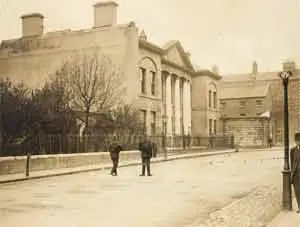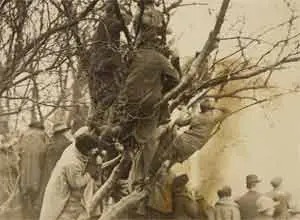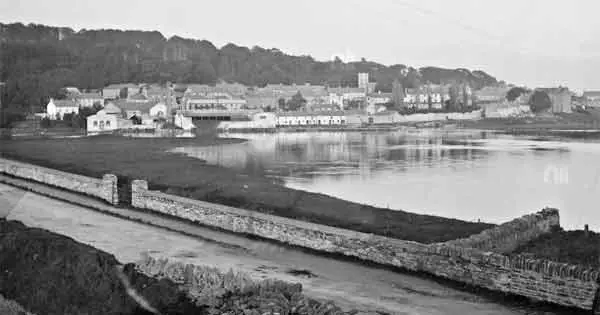Author Colm Wallace tells the chilling story of William O’Shea, who was the only Waterford man to be hanged in an independent Ireland.
By February 1943 William O’Shea had been married to his wife Maureen for three years, although he was aged just 24 and she was 21.
At this point the couple were blessed with a baby girl, the young family living together in a nice cottage in Ballyhane, outside Cappoquin. Instead of being at the start of a happy matrimony and enjoying parenthood however, O’Shea seemed to resent his wife. She, in turn, was afraid of him.
William O’Shea may not have been a devoted husband but he did earn a living by working for Waterford County Council doing odd jobs and was also considered good at trapping rabbits.
It was early 1943 that he had begun to spend a lot of time with a 17-year old local youth by the name of Thomas White, despite the significant age gap. White, who it would be later ascertained was mentally subnormal, frequented the O’Shea household and Maureen did not approve of the amount of time he and her husband spent together.
‘Unmistakable odour of smoke’
On the 22nd February, Thomas White came to the O’Shea household to enquire about a pair of shoes. William was absent from the house so White conversed with his wife, before leaving several minutes later.
The young mother then went to bed with her young infant and was on the verge of sleep when she smelled the unmistakable odour of smoke. The thatch of the cottage had suddenly gone up in flames and the occupants made a hasty exit. Maureen and the child were fortunate to escape with their lives.
The young bride’s family did not, however, believe that the fire was a terrible accident. Maureen had already begun to think that O’Shea and White had ideas about killing her and had informed her family of her suspicions. Maureen’s stepfather even accosted William O’Shea, insisting that the fire had not been accidental. O’Shea did not respond but his wife tellingly remarked “Oh well, they want to get rid of me, and the baby, and I suppose they will get me yet.”

William O’Shea and his wife were forced to live in O’Shea’s mother’s house after the fire had made their cottage uninhabitable.
On the 15th March, three weeks after the blaze, O’Shea returned home from work at 6pm as was his normal routine. After dinner, he uncharacteristically invited his wife on an evening stroll.
She agreed and the pair left the house. As they were walking arm-in-arm in Knockyoolahan, a townland close to their home, a shot rang out without warning. Maureen slumped to the ground.
The gun, a firearms expert would later testify, was only a couple of inches behind the unfortunate woman when the shot had been fired. Instead of staying with his dying wife, William O’Shea left her lying on the road and ran to his mother’s house.
He was in the house for several minutes without mentioning the horrific incident that had just occurred. Finally when his mother enquired as to Maureen’s whereabouts he told her that his wife had been shot.
When asked why by his panicked mother he hadn’t stayed by her side, O’Shea replied “I couldn’t bear it.”
Maureen died from shotgun wound
By the time she was discovered it was too late, the Maureen O’Shea having died from the shotgun wound. When the deceased woman’s family were informed about the tragedy they were far from being sympathetic, the stepfather openly voicing his suspicions.
He said accusingly to O’Shea “You were after spilling blood tonight, my boy,” O’Shea reacted by jumping from his chair and saying “Do you think I shot her?” He made no denial of the charge, however.
The Gardaí were quick to act on the suspicion. Later that night, they went to the house where Thomas White was staying and discovered a shotgun under the bed.
On 16th March O’Shea was summoned to the station in Cappoquin. Almost immediately he complained bitterly about his recently deceased betrothed “My wife has been at me since about the first week of our marriage. Anybody that used to come in she used to be fighting with them.”
Later in the statement he admitted that White burned his house. “White said that he would do it, but I was not sure he would. He told me he set fire to the back of the thatch…he was disappointed she had not been caught in it.”
O’Shea also knew that White had fired the fatal shot. He said in his statement that White had said “If we could get a cartridge we could shoot her…I knew it was Tommy White that had fired the shot because we had arranged that he do it.”
O’Shea went on to confess that when he felt his wife going down he whispered an act of contrition gently in her ear. In a later statement, O’Shea admitted that White had told him that the signal he was about to shoot Maureen would be a tap on the shoulder.
Prisoner suffering from a mental deficiency
O’Shea and White were tried jointly, the case beginning in Green Street, Dublin, on the 7th June. Thomas White’s counsel immediately asked if the jury could rule on the sanity of their client, the judge granting their request.
Dr. John Dunne of Grangegorman Mental Hospital told the court that he been examining White in Mountjoy. His conclusion was that the prisoner was suffering from a mental deficiency and that he would be unable to follow the proceedings of the court.
The jury retired for ten minutes before returning with a verdict of “not sane.” White was not fit to face the court and instead would be detained at the government’s pleasure. O’Shea thus faced trial for the murder of his wife alone.

O’Shea had already confessed to conspiracy to murder. However, he sensationally withdrew his statement before the court case, complaining “I never arranged to have my wife shot.
I don’t even remember saying that. That is all I have to say.” The defence Solicitor, Mr. Nolan-Whelan, said that there was no evidence to suggest a conspiracy between O’Shea and White.
O’Shea had no drinking problem and no motive. “A man does not murder his wife without a motive, unless he is insane,” continued the solicitor.
He also declared that the statement made by his client was involuntary and made under duress.
They also stated that there was a case for an insanity, one doctor declaring that O’Shea’s mental age was about seven years.
The prosecution disagreed and contended that he was acting simply to fool the jury into declaring him unfit to stand trial.
Guilty of murder
After the evidence the jury were given their chance to decide the truth. They needed fifty-five minutes to decide that the defendant was guilty of murder.
O’Shea was visibly trembling and did not reply when asked if he anything to say. The judge told the jury he agreed thoroughly with their verdict before donning the black cap and sentencing O’Shea to be hanged.
Several appeals were mounted against the sentence and the government cabinet of the day met to discuss a possible reprieve.
In this case however, they chose to let justice run its course. Despite not firing a shot, William O’Shea was hanged in Mountjoy Prison on the 12th August, 1943.
He would be the only Waterford man to climb the scaffold in the history of Ireland’s independence.
Colm Wallace has written a book “Sentenced to Death: Saved from the Gallows” about thirty Irish men and women who had the death penalty imposed on them between 1922 and 1985.
For more information see the author’s Facebook page or contact Somerville Press, Dromore, Bantry, Co. Cork. 028-32873
More popular articles and videos
The real life mystery of what Maureen O’Hara whispered to make John Wayne look so shocked
Matt Damon winning hearts and minds with charm assault on Ireland
Action hero Tom Cruise was once attacked by an old man in a Kerry pub
Liam Neeson speaks about his late wife in emotional interview
Dating site explains why Irish men make wonderful husband material
Billy Connolly says public should ignore politicians and listen to comedians
Take a look inside Hollywood star Saoirse Ronan’s stunning Irish home

